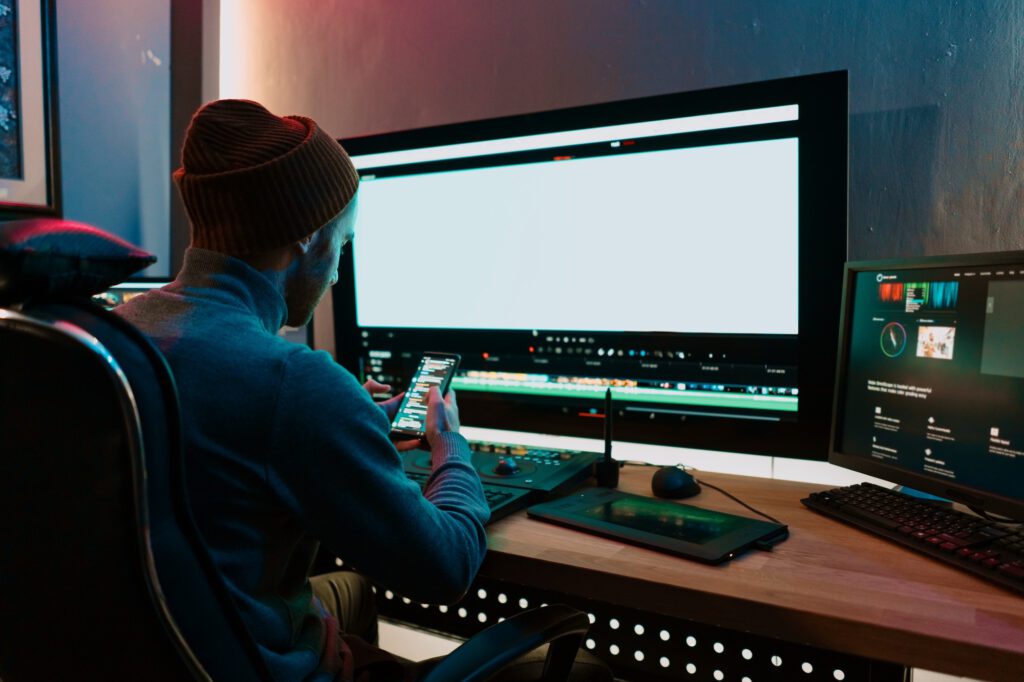Video is everywhere in 2025 — from YouTube and Instagram to online courses, ads, and business presentations. If becoming a video editor has ever crossed your mind, there’s no better time to start than now. This guide will walk you through everything you need to know, step-by-step, with simple language, practical tools, and direct links to help you start your journey.
✅ What Does a Video Editor Do?

A video editor takes raw footage (videos, images, audio) and turns it into a polished, professional video. This includes:
- Cutting unwanted parts
- Adding transitions, music, effects, and text
- Syncing audio and visuals
- Coloring and styling the video
- Exporting the final file for different platforms
Video editors work on:
- YouTube videos
- TikToks and Reels
- Documentaries
- Short films
- Online ads
- Courses and tutorials
- Business and corporate videos
Opportunities include remote work, freelancing, or full-time roles within agencies and media firms.
🧠 Skills You Need to Become a Video Editor
A formal degree isn’t required — what matters most are your skills and creative abilities. Here’s what matters:
1. Understanding Editing Software
Learn how to use editing programs (free or paid). We’ll list the best below.
2. Storytelling Sense
You must know how to build emotion, rhythm, and flow. The story is more important than fancy effects.
3. Basic Audio and Color Editing
Learn how to clean up audio, adjust volume, and color-correct your footage.
4. Speed & Efficiency
Clients want fast delivery. Learn keyboard shortcuts, templates, and workflows.
5. Attention to Detail
A good editor notices everything — bad cuts, loud audio, spelling mistakes, and awkward transitions.
Read more: The Smart Career Path: The Best Jobs to Do in 2025
💻 Best Video Editing Software for Beginners (Free & Paid)

Here are the top tools you can use — with links to each website.
1. CapCut (Free)
- Super beginner-friendly
- Used for Reels, TikToks, and short-form content
- Available on capcut
2. DaVinci Resolve (Free & Paid)
- Professional-grade editor
- Great for color grading
- Free version is powerful
- Download at blackmagic design
3. Adobe Premiere Pro (Paid)
- Industry standard
- Best for full-time editors and agencies
- Available via subscription at adobe
4. Final Cut Pro (Paid, Mac only)
- Ideal for Mac users
- Fast, smooth, and professional
- Buy from apple
5. HitFilm (Free & Paid)
- Good for YouTubers and short films
- Offers effects and VFX tools
- Download at fxhome
🎓 Where to Learn Video Editing (Free & Paid)
Here are the best places to learn video editing online — no degree needed.
1. YouTube (Free)
Tons of tutorials on every software.
Search for:
- “DaVinci Resolve beginner tutorial”
- “CapCut editing tips for Reels”
- “Adobe Premiere Pro transitions”
Start here: youtube.com
2. Skillshare (Free trial, then paid)
Great courses for complete beginners and professionals.
Visit: skillshare.com
3. Coursera (Free & Paid)
Professional video editing courses from universities.
Check out: coursera.org
4. Motion Array (Paid)
Offers templates, stock footage, music, and tutorials.
Visit: motionarray.com
Read more: How to Write the Perfect Resume in 2025 (Step-by-Step Guide)
🛠 Build Your Portfolio (Even if You’re a Beginner)
To get clients or jobs, you need to show your work. Here’s how to start:
1. Practice with Free Footage
Use sites like:
Download footage and create mini-projects like:
- Instagram ads
- Short vlogs
- Travel edits
- Product promos
2. Create a Personal Brand
Upload your videos on:
- YouTube
- Behance (behance.net)
- Instagram Reels
- Your own website (use Wix or Notion)
💼 Where to Get Jobs as a Video Editor in 2025

Once you have skills and a small portfolio, you can start getting clients or jobs.
1. Freelancing Platforms
- Fiverr – Set up a gig at fiverr.com
- Upwork – Bid for projects at upwork.com
- PeoplePerHour – Great for UK and global clients: peopleperhour.com
Tips:
- Start with low pricing to gain reviews
- Deliver work fast and with high quality
- Communicate clearly with clients
2. LinkedIn Networking
- Build a strong profile with your sample videos
- Connect with content creators, agencies, and business owners
- Post your edits regularly using hashtags like
#videoeditor,#contentcreator,#freelancer
Create a free profile at linkedin.com
3. Apply for Remote Jobs
- Use platforms like:
Search terms to use:
- “Remote video editor”
- “Motion designer remote”
- “Content editor freelance”
Read more: How to Build a Personal Brand That Gets You Hired in 2025
🧩 Optional Tools That Help Editors Work Faster
To stand out, use extra tools to speed up your workflow:
– Canva: For creating thumbnails and social media graphics
– Epidemic Sound: Royalty-free music for videos
– Envato Elements: Templates, transitions, and sound effects
– Frame.io: Collaborate with clients and review feedback
💬 How Long Does It Take to Become a Video Editor?

If you practice 1–2 hours daily:
- Within 30 days: You’ll understand basic editing
- In 3–4 months: You can start freelancing or working on real projects
- In 6+ months: You’ll have a strong portfolio and income potential
🚀 Bonus: How to Stand Out as a Video Editor
- Pick a Niche: Be the “YouTube editor,” “wedding reel editor,” or “course content editor”
- Use Templates: Speed up delivery and boost quality
- Stay Updated: New trends like vertical editing, AI subtitles, and short-form cuts are hot
- Offer Extras: Add thumbnail design, captions, or YouTube optimization
✅ Conclusion
Becoming a video editor in 2025 doesn’t require a degree or expensive setup. You just need:
- A computer or smartphone
- Editing software (many are free!)
- Patience and consistent practice
Start learning, build a small portfolio, and get your first client online. Whether you want a side hustle or full-time career, video editing is one of the best creative jobs right now.


